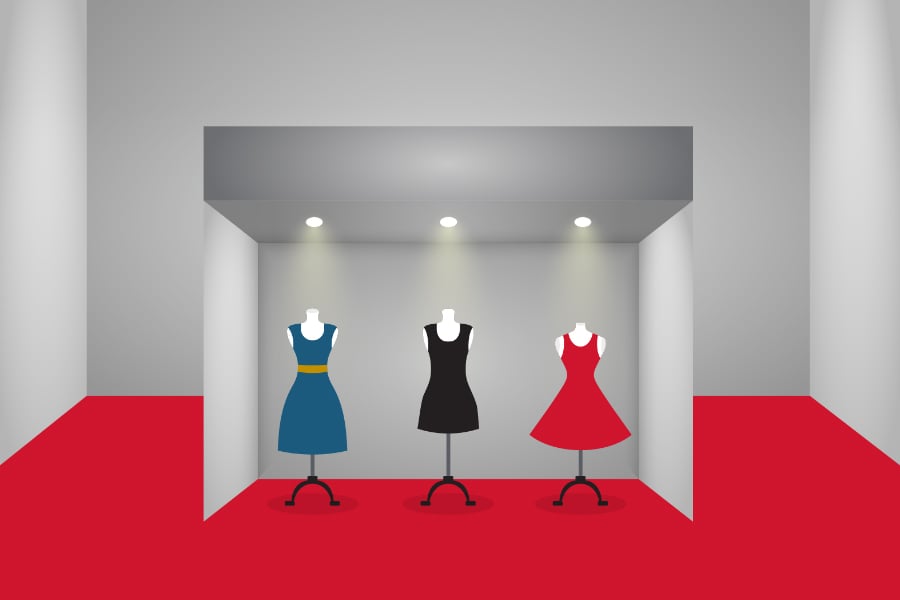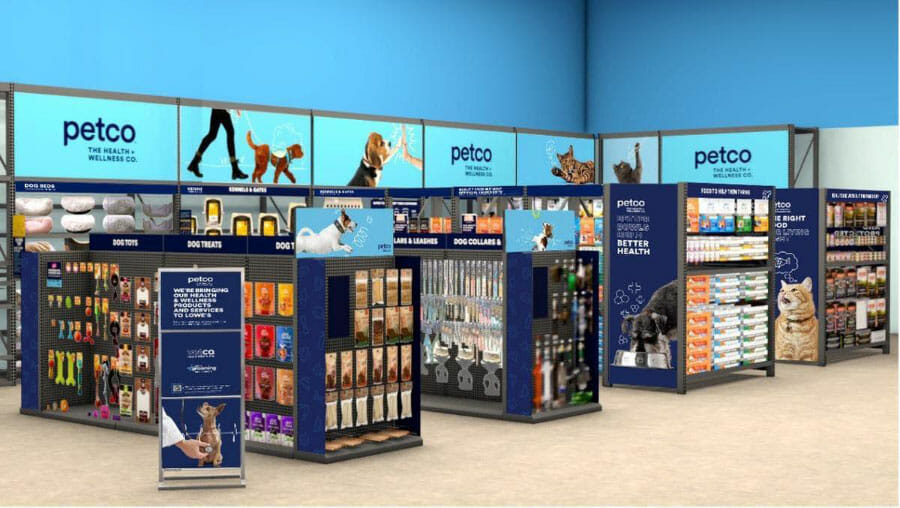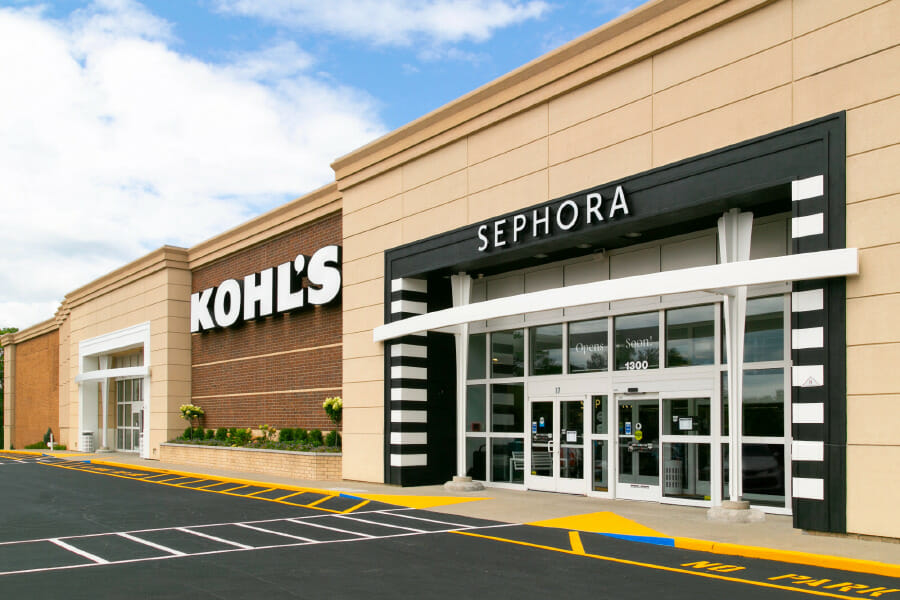Logistics
Industries
Technology & Innovations
E-commerce
E-commerce Fulfillment Services
Lease & Maintenance
Semi Trucks
Logistics
E-commerce
Lease & Maintenance
Buy Used Trucks

[Updated post from October 5, 2021]
The rise of e-commerce - and the corresponding decline in foot traffic at brick and mortar storefronts - has left legacy retailers scrambling to entice consumers back into stores. Between Q4 of 2019 and Q1 of 2021, the store count of department stores across the U.S. declined by a third (33%).
With brick and mortar retail now recovering from the COVID-19 pandemic, retailers are taking bold steps to reinvent their storefronts and give more reasons for shoppers to come in-store. One of the most popular strategies is SWAS, also known as ‘store within a store'.
Right now there's a host of large and small brands diving into SWAS partnerships with well-known storefronts. But what exactly is SWAS, and why are so many retailers jumping on board?
Store Within A Store (SWAS) is a retail store concept where a large retailer offers floor space for another brand to set up a dedicated section. This can either be a permanent arrangement or a temporary pop-up strategy to drive foot traffic and brand awareness.
Retail stores that most commonly host SWAS initiatives include big-box retailers and department stores, though more specialized storefronts like hair salons can also benefit from this shop concept.
A store within a store section is designed to reflect the brand's unique identity so it looks distinct from the rest of the storefront, and usually sits in a high-traffic area. Many SWAS storefronts will involve value-added offerings in addition to selling products that are already available online. This may include tutorials, roundtable discussions, exclusive product samples, or meet-and-greets. These activities are designed to enhance the customer experience and drive a buzz around the brand and the host retailer.
The goal of the SWAS model is to assist emerging brands with showcasing their products offline by leveraging the customer base of their host retailer. In exchange, the retailer earns revenue by renting square footage and/or taking a cut of any sales proceeds. They also benefit by offering a wider range of products and services without having to invest in inventory, marketing, and other expenses associated with expanding in-house offerings.
The classic ground-floor cosmetics hall is a classic example. The floor space is filled with a multitude of beauty brands, each with its own miniature storefront to display products. Each ‘storefront' is staffed by representatives who give recommendations, demonstrate products, and facilitate transactions. In effect, the end-to-end shopping experience in a SWAS store is decoupled from the host location entirely.
This makes the selection of SWAS locations a critical part of this store model. Department stores have been using SWAS for decades to get more brands under one roof, without taking responsibility for more inventory or staffing. Big-box stores, meanwhile, are relative newcomers to this store concept, but are pivoting in response to customers wanting to access more products and services in one place.
Online shopping might not have killed off physical storefronts, but that doesn't mean it hasn't changed the way consumers want to shop for products.
If we look at the most popular e-commerce stores worldwide, they all have one thing in common; none of these retailers specialize in any one product category. From apparel to beauty to home decor and even groceries, they boast an impressive range of product categories. Given how shipping costs can quickly mount up in e-commerce, it's not surprising that consumers are gravitating to stores where they can get everything they need in one place.
But this push for convenience presents a challenge to brick and mortar storefronts. Expanding into new product categories is always a risk, especially if a brand doesn't have a reputation in that space. It also means taking more responsibility for merchandising, inventory selection, and supplying more labor, which escalates running costs.
SWAS storefronts offer larger retailers creative ways to take a share a bigger share of consumers' regular spending, while taking advantage of brands that consumers already know and trust. Great examples of this include Macy's SWAS partnership with Starbucks, Target pairing itself with CVS pharmacy, and Lowe's x Petco.

These store within a store initiatives all capitalize on bringing together products that consumers routinely purchase, but can't always do under the same roof. This enhances convenience as well as boosting the odds of impulse buys.
The birth of e-commerce has transformed consumer shopping habits, so it's surprising that this has caused commentators to question whether brick and mortar is still relevant.
Today, consumers are just as likely to discover new products online and view social media as they are in-store. 42% of shoppers globally say they've made a purchase through a social media platform, thanks to the rise of social commerce. Moreover, 81% of consumers say that they research a product online before purchasing.
While today's consumers have never been more comfortable discovering, researching, and buying products online, this doesn't mean that brick and mortar is dead. In fact, many retail stores are finding that the physical storefront is still their most important channel.
A study by Insider Intelligence that surveyed 13 major brick and mortar retailers - including Walmart and Target - found that their in-store audiences were on average 70% bigger than their online audience.
Following the COVID-19 pandemic, many retailers are focusing on what consumers have been missing most during the pandemic: Tactile experiences. 70% of customers rank the ability to try, touch, and see physical products as their favorite part of the in-store experience.
The SWAS store model is a valuable strategy to keep in-store experiences interesting and fresh for customers. Moving away from the static storefront in favor of evolving experiences gives customers an incentive to regularly visit in-store to see ‘what's new'.
The store within a store concept has become the logical extension for the growing number of retail partnerships between direct-to-consumer brands and legacy stores. For D2C brands, the benefits of a SWAS approach are obvious. It helps to reduce overhead costs and allows emerging brands to scope out new consumer segments they are struggling to reach online.
With many brands having maxed out their online audiences and facing increasing acquisition costs, many successful D2C brands have taken the plunge of taking their products offline into participating retailers.
Gen Z-oriented skincare brand Bubble joined the shelves of Ulta Beauty, CVS Pharmacy, and many Walmart stores last year, where they have seen sales growth as high as 300% thanks to viral TikTok campaigns and being in such accessible storefronts.
However, it's not just D2C brands that are focusing on perfecting their SWAS strategies. Traditionally standalone storefronts are also experimenting with shrinking down their square footage, especially in locations where having a standalone store doesn't make financial sense.

Both Sephora and Ulta Beauty are currently experimenting with big-box store partnerships that put miniature and full-sized store footprints within high-traffic areas. Kohl's recently announced that 250 of its stores would have 2,500-square-foot Sephora SWAS locations added during 2023. Ulta Beauty, meanwhile, is planning for 800 small-format SWAS locations at Target storefronts. The purpose of the SWAS store model for established retailers is not just boosting their footprint, but ensuring they can continue reaching young, diverse consumers that might not have a standalone store location within easy reach.
Scalability in fulfillment is easily the biggest challenge faced by D2C brands as they grow. While it's possible to self-fulfill orders when you're only handling a few hundred per month, this system quickly gets overwhelmed once order volumes increase. To keep pace with growth, brands have two main options: To spend considerable sums on infrastructure and labor, or to bring in a D2C fulfillment provider.
SWAS partnerships offer businesses an alternative solution. By placing their products in a storefront, the host retailer takes responsibility for inventory management and the fulfillment and shipping of orders placed via their online store. This takes pressure on D2C fulfillment operations and enables them to introduce popular service offerings such as BOPIS, curbside pick-up, and rapid home delivery.
Both the host and the incoming retailer must benefit. A SWAS partnership is doomed to fail if there isn't a fair exchange. For example, the host retailer may want to attract a new generation of foot traffic by bringing in a youth-focused brand, while the brand wants to take advantage of greater reach and marketing opportunities. If there's no mutual benefit, then a SWAS project doesn't make sense.
A shared customer profile. While your target audience doesn't have to be exactly the same, there needs to be enough of an overlap to boost foot traffic and provoke interest in the partnership. If there isn't, brands need to question whether a collaboration offers value.
Location, location, location. The location of SWAS concepts isn't just important to get potential customers in the door, but for brands to get some on-the-ground data on whether a certain neighbourhood may warrant its own standalone store in the future.
Enhancing convenience. Most customers aren't going to go out of their way to visit a SWAS location, so your concept needs to promote convenience just as much as novelty. Your product selection should complement and expand on what is already available at the host retailer, so shoppers feel more inclined to explore.
Experiential retail is where it's at. Retailers can provide unique value by offering experiences in-store that shoppers cannot get online. Opportunities to discover brands and test out new products enhance the in-store experience and strengthen loyalty in your customer base.
Convenience is king. Consumers might prefer physical retail, but they enjoy the benefits of shopping at a single storefront the way they do online. Consolidating
Physical stores are a crucial touchpoint – but not always the point of purchase. Instead of trying to compete directly with e-commerce, storefronts need to start shifting their focus from driving transactions to facilitating greater omnichannel activity. Allowing customers to book an appointment via the website for a product demo, for example, enables storefronts and SWAS initiatives to play a much bigger role in the shopping journey.
A bigger focus on curation and localization. Moving away from identikit storefronts and giving stores their own unique character is proving a successful strategy to revive interest in brick and mortar. Localized product selections and choosing to rent space to local retail projects gives consumers more incentive to make regular store visits.